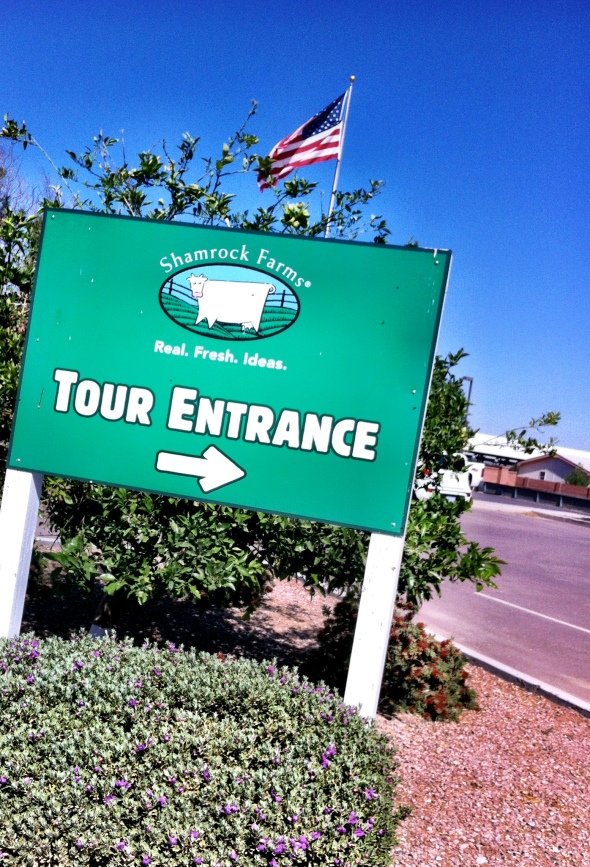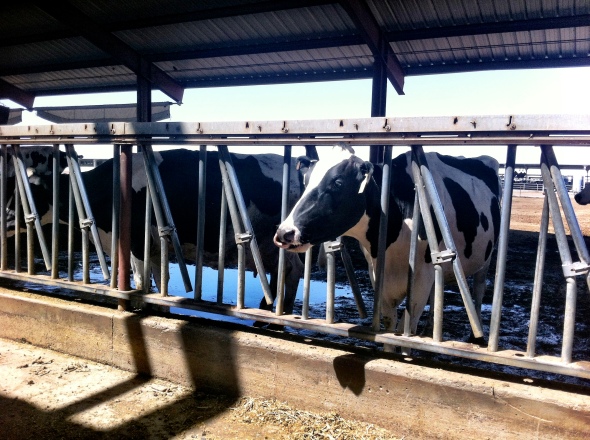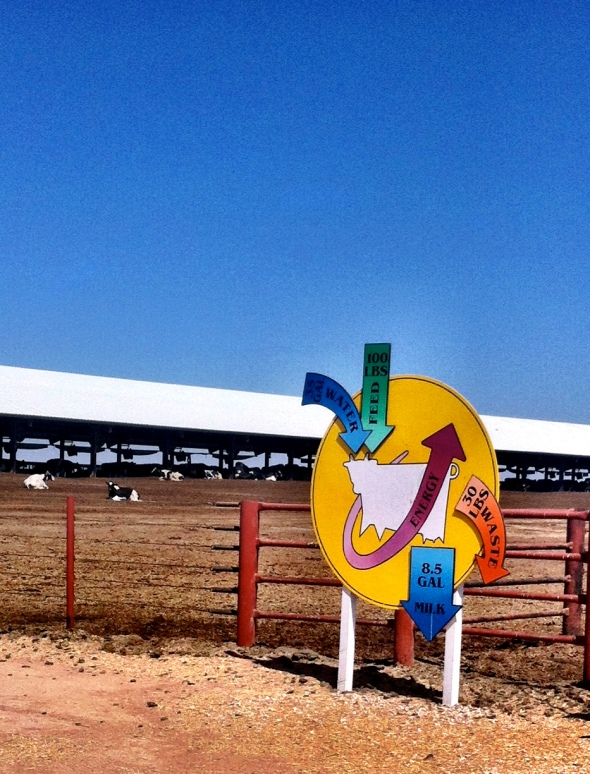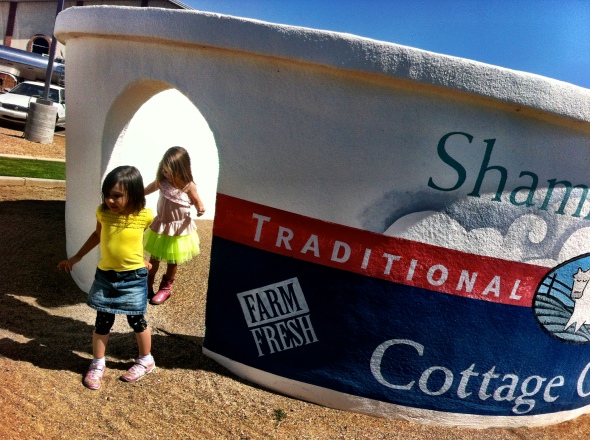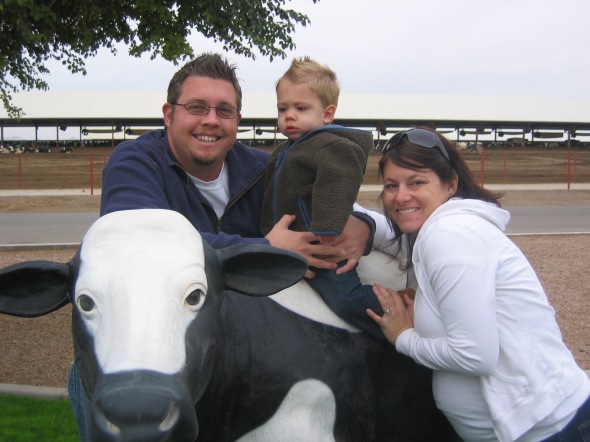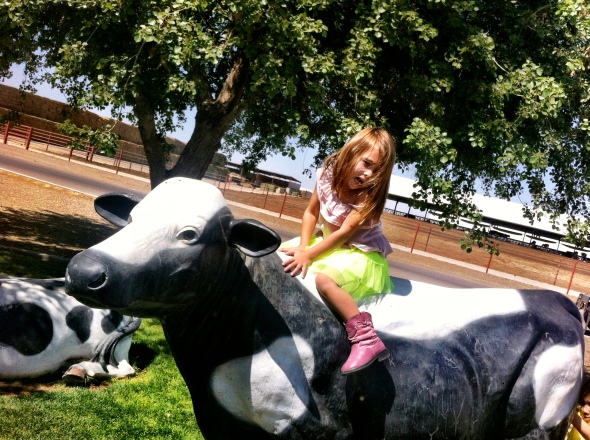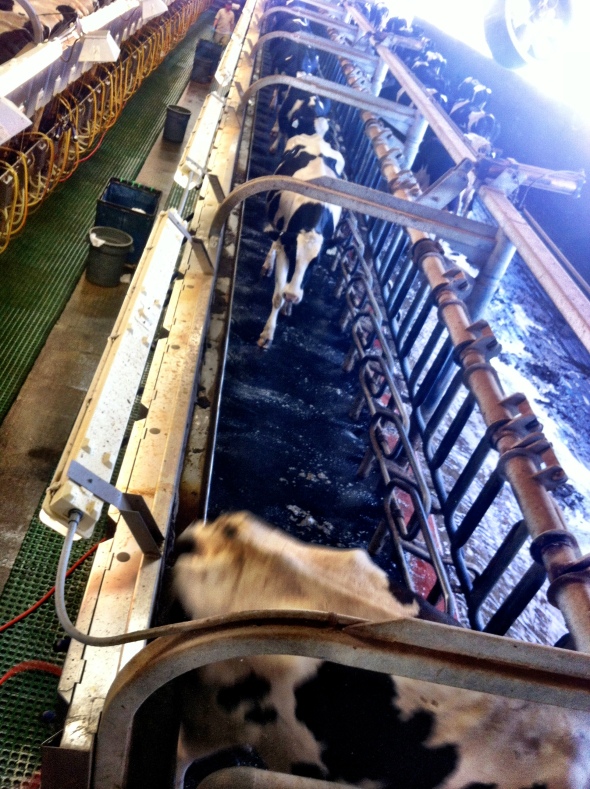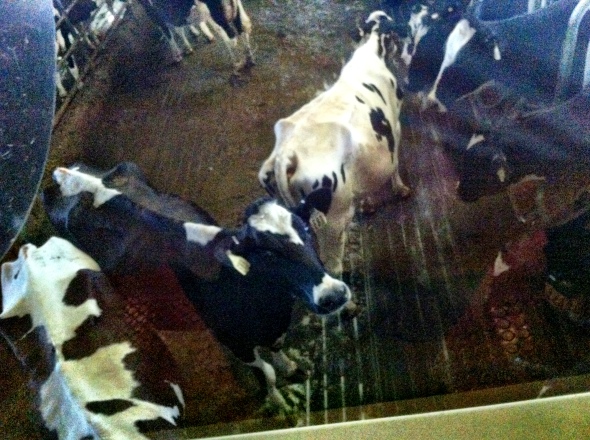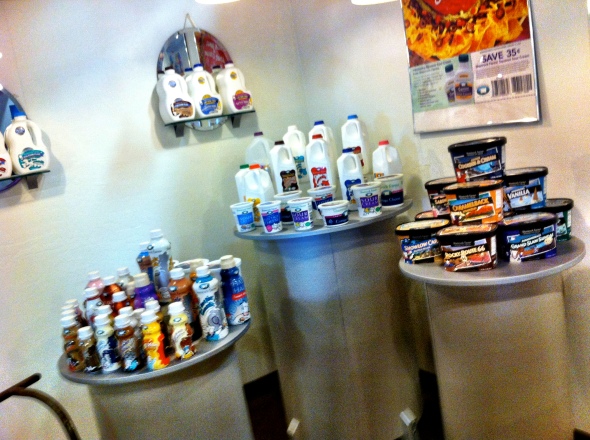farm life is not as simple as it seems
Posted: April 30, 2013 Filed under: Arizona, cows, eco-friendly, farm animals, healthy eating, Phoenix, Uncategorized | Tags: Cattle, Dairy, Dairy farming, family activities, healthy eating, Holstein cattle, Milk, Shamrock Farms 3 CommentsMy daughter and I were invited to spend a simple day at the farm–Shamrock Farms. I’d been there once before, about four years ago, just a few weeks before my daughter was born. I remembered it fondly and was excited to go back, but I was also a bit nervous.
Since I’d last been there, our family has made a lot of lifestyle changes. We exercise regularly, we mostly don’t do processed food, we don’t buy paper towels, and…we make more vegan choices. I’m not able really to define it, but, well…I have no idea what I’m doing. I just know that I’ve watched my share of inspiring, influential documentaries, and there I was, confused at a dairy farm.
Shamrock Farms was as delightful as I’d remembered. Every staff member we came in contact with was a pleasure to meet and treated us as if we were old pals, which stands to reason, as the farm’s philosophy is to treat it’s customers like friends and it’s employees like family. The facility has been family run since 1922, and was begun with a few hand-milked cows and local delivery of fresh milk in glass bottles. Ah, the good ol’ days.
We boarded the tram and got “MOO-ving” for a tour of the working farm.
Even though it is the largest family-run dairy farm in the southwest with over 10,000 cows, Shamrock Farms “loves” their herd, and set out to show us how. Since the farm produces milk and related products, all of the cows are female black and white Holsteins, and referred to as “the sisters.” When not being milked, the sisters spend their time in the “Desert Oasis, where luxurious spa treatment produces quality milk.”
In the Desert Oasis, the sisters have plenty of shade from the intense desert sun, and their shelter is complete with misting fans, something I wish I had in my own back yard. Heat stress will reduce the milk the ladies produce, so they are kept quite comfortable. Their oasis has areas where they can roam free, which seemed to have more than ample space. It is equipped with feeding gates to enhance their dining experience by keeping things non-competitive at feeding time. They can choose when to eat and when to roam…when to bask in the sun, and when to chill in the shade. They seemed calm and happy.
Our tour guide shocked us with statistics about what it takes to produce the milk we drink. Each day, each sister eats 100 pounds of food and drinks thirty-five gallons of water (about a bathtub full). This fuel allows the cow to produce thirty pounds of waste and 8.5 gallons of milk. Every cow. Every day. The good news is that Shamrock Farms recycles the cow waste into fertilizer to grow their food, and they also use recycled water.
Their diet consists of different types of hay with vitamins and molasses (for taste) mixed in. Maintaining their “café” is a big job. The sisters eat 90,000 pounds of hay each day! The variety they eat depends on their dietary needs at the time, and Shamrock farms provides them with variety, which is important in any diet.
We made a pit stop at the kids’ adventure area, where the little ones were given a chance to wiggle and play. They also had the opportunity to hook their fingers up to one of the milking machines used by the farm. As described, the experience was gentle, like a massage, which was a relief to all. The kids got to go down a cottage cheese slide, among other dairy-themed adventures.
As I mentioned, the last time I visited the farm, my daughter wasn’t quite born. We took a family photo on the stationary cow that day (the protrusion in my mid-section is Campbell).
And, then, the other day, I forced Campbell atop the same cow. As you can see, she loved it.
I’m going for the triptych, so she’ll have to pose again when she’s sixteen.
Moo-ving on, we next visited the “milking parlor.” We saw the sisters file in calmly, be milked by the gentle massaging machines, and then leave just as calmly and orderly as they arrived. I found it interesting that there are a few “type-A” cows in every herd who lead the other sisters into the milking parlor in the same order every time. If we ever doubted their intelligence…
The sisters all seemed quite calm while they were being milked, a process they undergo twice a day, every day. Our tour guide told us that they receive a shower before each milking, and that the whole process of showering and milking, from start to finish, takes between 4-7 minutes, only.
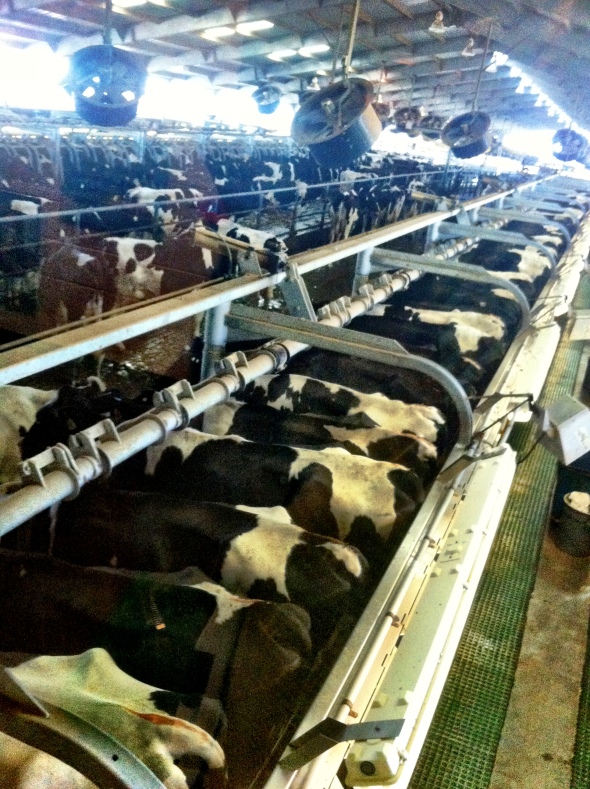
The “milking parlor.” Markings on the sisters’ backs may indicate any health issues, how many times they have been pregnant, or whether they are soon going into heat.
There are some special areas for cows with particular needs, such as a “maternity ward” for mama cows. The soon-to-be moms stay in the ward beginning three weeks before their due date, and are also provided an after-birth care area with other new moms. It is a place where they can be monitored closely by staff veterinarians. Their care includes a “manicure,” (hoof treatment), which any new mom can appreciate. Considering the farm sees thirty to forty births per day, this component of the farm is crucial, as is the “nursery,” where all of the new babies go. The babies are bottle-fed from the start, first with their own mother’s colostrum, and they are bucket-weaned three to five days after birth. They stay in very small, individual pens for approximately two months, in order to keep them safe and ensure that they get proper nutrition. They are then moved to a larger pen with a small herd, and then gradually move into larger pens with more sisters.
Beginning at about age two, the cows have between four and six babies (one, very occasionally two at a time) during their lives at Shamrock Farms, which is usually about seven or eight years.
Shamrock farms has a “traditional” herd and an organic herd. The organic herd can not be treated with antibiotics or added hormones (the traditional herd does not have added hormones, either, which is nice), and their food can not be treated with pesticides. Unfortunately, many organic herds suffer because though a cow may be very sick, they are not treated with needed antibiotics. Their milk production is valued more than their comfort, so they are left to suffer and sometimes die so that they can stay “organic.” Not so at Shamrock Farms. Since they have both an organic herd and a traditional herd, they are able to treat a sick organic sister with antibiotics, if needed, then simply move her to the traditional herd. Shamrock Farms really does seem to care about their animals.
The main difference in the organic herd, aside from the lack of antibiotics, is in what and how they eat. They have access to pasture 180 days out of every year, and there are no pesticides whatsoever in their food. Many times we don’t think about pesticides being in our dairy, but what goes into the cow affects what comes out, so it’s important to make sure you understand where your food comes from and what goes into it, every step of the way.
All Shamrock Farms Cows are born and remain on the farm for the duration of their calf-producing, milk-making years. As dairy farms go, I believe Shamrock Farms is one of the best. The animals seem happy and healthy, and they are treated better than other large dairy farms I’ve researched. That doesn’t take away the inherent problems in dairy farms, which is a topic for another time, but can’t be ignored. Yes, any animal that does not produce milk, which include all of the males born and the females beyond cow-bearing years, are collected by the meat broker. “The circle of life” is how it was decreed by our tour guide (of course, this was not actually part of the tour, but something I asked on the side). Regardless of my beliefs, whatever time the cows spend at Shamrock Farms is as good as it can be.
The people at Shamrock Farms pulled out all of the stops for us, and we even had the opportunity to try one of their soon-to-be released products, flavored sour cream, due out in June. The newest addition to their product lineup is a result of focus groups and consumer feedback.
The flavored sour cream will be quite versatile. “Dip it. Mix it. Top it” is the message they want to communicate. There will be simple applications, and the sour cream should be an exciting enhancement to recipes, as well. The sour cream will come in three flavors: ranch, french onion, and–my favorite–jalapeño. For dairy-consumers, this is a healthy alternative to highly processed dips and dip mixes, as they are minimally processed with no added hormones and are locally made (for those of us in AZ). They will come in 12-ounce tubs and will be priced about the same as regular sour cream, about $2..99. It was fun get the inside scoop on a product that isn’t available yet in stores!
We had a great day at Shamrock Farms. I would highly recommend checking out your local dairy, and if that’s Shamrock Farms, all the better! Their hospitality makes you feel like you’re back in the 1920’s when the farm began, while their technology and ideas are ahead of their time.
Above all, please educate yourself about the quality of the food you put into your body, and know how the animals who make–or who are–your food are treated.
Disclaimer: I was invited to visit Shamrock Farms and received a complimentary day of activities, but all opinions are my own.
you never know what might happen when your mom is a pet sitter
Posted: April 11, 2013 Filed under: cats, healthy eating, junior pet sitters, pet sitting, pet waste, pets, work from home mom | Tags: cat litter, cats, healthy eating, junior pet sitters, kids say the darndest things, parenting, pet sitting, pets, shopping with kids 1 CommentI try to make most of our food and avoid the processed stuff. But sometimes you just have to break the rules. When my four-year-old daughter, Campbell, saw the angel food cake with a dusting of pink confectioner’s glitter on top at the “regular” grocery store bakery today and looked at me with those “mommy, can we keep her?” eyes, I couldn’t resist. Sometimes happiness is worth a bit of guilt.
She had me pull it out of the fridge to take a gander about every five minutes until the boys got home from school. She was quite confident that they would share her excitement. Our teen thing, B, told her there was no way he was eating it.
Fine. No desert for you.
She hoped that her six-year-old brother would be on her side. “Po! We got a cake at the store, and it has pink glitter!”
“WHAT?” he demanded. “It has KITTY LITTER? I’m not eating that, either!”
When your mom is a pet sitter, your mind just goes there. Next time we’ll opt for the Almond Rocha surprise cake.

